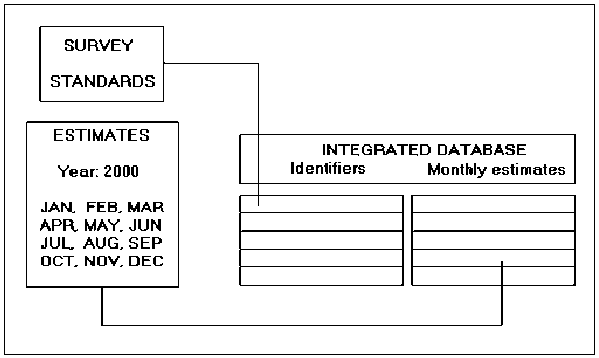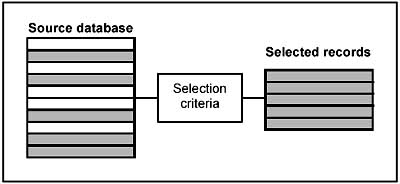12.1 GENERAL-PURPOSE DATABASES
12.2 FUNCTIONAL CHARACTERISTICS
12.3 REGIONAL DATABASES
The previous sections reviewed the various steps in designing and implementing fishery surveys involving basic fishery data. They also presented practical approaches to computing techniques for organizing primary data and producing catch/effort estimates within the logical context of a minor stratum, a month and a boat/gear category.
In this section data processing concepts on accessing and using basic fishery statistics are discussed, including:
After completing an operational cycle (usually a year, it is useful to integrate monthly estimates into a single database for a variety of applications, such as bulletins, analytical studies, submission of data to regional and international bodies, etc. Table 12.1 illustrates an example of such a database that can be produced automatically from existing monthly outputs.
Table 12.1 Example of an integrated database
In this example the database structure consists of:
(a) Four identifiers (major and minor stratum, boat/gear type and species).
(b) Monthly figures of estimated catch, effort, CPUE, prices and values.
(c) Yearly totals for catch, effort, values and averages for CPUEs and prices.
12.2.1 Creation
Creation of an integrated database is automatic and performed as illustrated below:

12.2.2 Flexible data selection
Users should be able to work on the entire database or on selected sub-sets. The figure below illustrates a flexible selection function, whose selection criteria could be:
(a) Select for major stratum A and shrimp for trawlers
(b) Select for gillnets in all strata and for all species
(c) Select for trawlers in all strata and for all species, etc

12.2.3 Data grouping
Data grouping functions use selected sub-sets or the entire database to produce sub-totals and totals at various grouping levels, such as totals by boat/gear for each species, by species for each boat/gear, by geographical major and minor stratum level, and/or at grand total level.
12.2.4 Data ranking
Data ranking is useful for highlighting data in terms of their relative importance within a selected database sub-set. For example, the following ranks are often useful to demonstrate in reports:
(a) Species with highest values12.2.5 Use of commercial applications software
(b) Boat/gear types with highest overall CPUE
(c) Boat/gear types that account for more than X% of total
(d) Species that account for more than X% of total value
(e) Minor strata ranked according to total production
(f) Major strata ranked according to total fishing effort
Customized computer systems that are built around known and standard application and user needs, however flexible, cannot respond to all user requirements. Commercial software applications (such as Word, Excel, Access, etc.) are useful tools that can support statistical and other studies and reports, provided that the required data can be made available. Therefore, an essential function of an integrated database system is to allow users to extract the required information from the database and transfer it to a commercial software package for further analysis and presentation. This is usually a straightforward process involving:
(a) Use of flexible selection criteria (discussed in 12.2.2).
(b) Use of data grouping functions (discussed in 12.2.3)
(c) Use of ranking functions (discussed in 12.2.4)
(d) Formatting the processed database records for easy transfer to an external application environment
The establishment of a regional database (RDB) is required when there is a need to conduct studies on shared resources of transboundary fish stocks (in lakes, rivers, between exclusive economic zones and extending onto the high seas). Development of an RDB is essentially a matter of standardization and harmonization. The following stages are usually involved:
12.3.1 Regional needs and standardization
(a) Identify the data scope for the short- and medium-term, (e.g. catch, effort, CPUE, prices, values, etc.).12.3.2 RDB development and implementation(b) Determine the required level of detail for each target regional data record, (e.g. time period, geographical identifier(s), fishing locations, boat/gear types and species level).
(c) Prepare a checklist to examine the feasibility of obtaining such data from contributing countries.
(d) Standardization of geographical, boat/gear type and species classifications.
(e) Prepare country-orientated lists for comparing national standards in use against the standard RDB classifications.
(f) Establish commonly accepted formats and operational modalities for data submissions (fishing boat logsheets, survey forms, etc).
(a) Design of a basic RDB architecture and preparation of technical specifications on the types of outputs, access to data and RDB maintenance requirements.(b) Select appropriate database engine and programming tools.
(c) Develop and test the RDB applications with data from contributing countries.
(d) Prepare operational guidelines.
|
SUMMARY In this section, data processing concepts concerning access and use of basic fishery statistics were outlined, including: (a) Setting up databases for general-purpose use. |